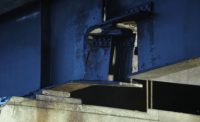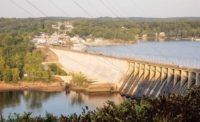The Columbia Parkway in Cincinnati is one of the more heavily trafficked roads in southwest Ohio. It provides a 6.4-mile connection between downtown Cincinnati and its eastern suburbs as it runs along the Ohio River. However, landslides on the steep slope above it have impacted travelers almost since Columbia Avenue was expanded in 1938.
Seasonal hillside instability has led to gradual downslope soil creep all the way from the East End neighborhood atop the hill. The most abrupt and severe landslide events were in 1975, when 160 ft of the parkway retaining wall were knocked down, and in 1996, when a slide mass abruptly slid across four of the five travel lanes.
When Columbia Parkway was constructed, most of the excavation behind the retaining walls was within bedrock. This stable bedrock slope, however, quickly weathered into a clay rich soil.
“The increasing thickness of the soil on the hillside has led to an increase in landslide activity,” says Richard Pohana, principal geotechnical engineer and project manager with the Cincinnati Dept. of Transportation and Engineering.
In May 2019, CDOTE put out a request for proposals (RFP) to firms short-listed from earlier request for information (RFI) submittals. The agency selected a design-build team of Beaver Excavating Co., Canton, Ohio, as the primary contractor and Geotechnology Inc., Erlanger, Ky., as geotechnical design consultant. The $17.8-million design-build stabilization project addresses 10 landslide mitigation sites along a two-mile stretch of the parkway.
Geotechnology’s solutions were soldier pile lagging (SPL) walls and soil nails with fence-like steel mesh to stabilize the hillside.
“During the RFI process, we came up with conceptual plans on soil nails in some areas, soldier pile walls in other areas,” says Joe Hauber, principal geotechnical engineer at Geotechnology. “After the job was awarded to Beaver, we went into some exploratory work. However, the exploratory work was predominantly restricted to the soldier pile wall areas, mainly due to the order of construction. Certain areas needed to be stabilized before other areas, but then after award and discussing it, it was decided with the city and Beaver to go from east to west with construction so that we could start bringing in traffic control measures to reduce the traffic impact as we went along.”
Due to the size of the area that needed to be explored and the access paths necessary for drill rigs or track hoes to get to boring and test pit locations, the exploration for the 10 areas was phased. Areas 7, 8, 9A and 10 were explored first in 2019. Areas 1 through 3 as well as 5 and 6 were explored in 2020. Crews completed a total of 10 borings and 58 test pits to assess the conditions of the underlying soil and bedrock.
“We started our access at the end of July 2019,” says Dan Reams, project manager, Cincinnati, at Beaver. “By November 2019, we started soldier pile walls in Area 10.”
Stable Solutions
During the exploration process, the project team discovered that stabilization was not immediately needed in Area 4 and, therefore, it wasn’t stabilized due to funding constraints, which added more length to the other stabilization areas. A landslide event in Area 4 wouldn’t directly affect the parkway. Movement in Area 9 required stabilization of the landslide in a separate emergency contract prior to the completion of the RFI/RFP process. Another area between 9 and 10 required stabilization and was designated Area 9A.
“During the clearing for those [construction] benches, we tested subsurface information and then confirmed or refined the design.” Hauber says. “If we were anticipating 5 feet to rock and it ended up being a little bit shallower, we adjusted the drawings; if it ended up being a little bit deeper, we adjusted.”
In Areas 1 through 3, 5 and 6, 90% of the design plans were completed prior to exploration, and design tweaks were added afterward.
SPL walls were generally specified where the sloping terrain closer to the roadway was flatter in comparison with the steeper areas selected for soil nail stabilization. The SPL walls consist of 24-in. to 36-in.-deep steel I-beams, 25 ft to 35 ft long and spaced at approximately 6 ft on center, spanning over 1,500 ft parallel to Columbia Parkway. The beams are placed in 3-ft-dia to 4-ft-dia boreholes that were drilled through the soil and extended 11 ft to 16 ft into bedrock and filled into place with concrete. Concrete lagging panels are placed in between the beams from the top of the I-beams to the ground surface on the low side of the wall to retain the upslope soils. Gravel backfill and weepholes through the concrete panels were included in the design and construction of the wall to provide drainage.
Due to the steep terrain that extends upslope of the SPL walls, landslides and soil creep are expected to continue toward the Columbia Parkway, but Geotechnology’s design of the SPL walls implemented two features to aid in keeping that slide debris off the roadway. The top of the SPL walls extends a few feet above grade on the high side of each wall to capture material from landslides. The SPL walls are also offset approximately 20 ft away from the original concrete retaining wall on the north side of Columbia Parkway. This creates a relatively level 20-ft catchment area to collect accumulated slide debris that may overtop the new soldier pile and lagging walls and keep it from getting to the roadway. If necessary, CDOTE crews can remove debris and maintain the catchment area in the future. Architectural beam covers and beam caps on the walls were added to fit in with the art deco style of the original project and add uniformity.
The steep terrain in Areas 5 and 6 already had a bedrock slope that was 40 ft to 50 ft tall above the parkway. In Areas 1 through 3, the soil that was coming down was already at the toe of the slope. In Areas 5 and 6, that soil was way up the slope and could build up significant momentum coming down.
“We put the soil nails up higher to pin this soil mass, and then we just TRMed [turf-reinforcing mats] the bedrock face below it,” Hauber says. “You get all of these little failure planes. Hummocky terrain is what we call it when the ground surface is uneven and it’s just all interrupted and you get all of these breaks in the slope because of the multiple slides.”
For the areas of slope that called for soil nail stabilization, Beaver is installing a Geobrugg wire mesh system that’s a heavy-gauge metal designed to hold the ground underneath it in place. A turf-reinforcing mat is placed beneath the steel mesh to prevent erosion and promote vegetative growth.
“It looks like a chain link wire fence but with a lot more tensile strength,” Reams says.
Each soil nail is embedded and grouted into a bedrock anchor and then attached to a steel mesh system. Each nail has a spike plate and a nut. Beaver fastens the spike plates onto the nails down into depressions called dells. The spike plate torques itself down into its anchor, and the spike plates have hooks known as ears at the end of the plate that grab the mesh and pull it taut and gives the steel mesh surface tension to hold the overburden soil against bedrock. Turf reinforcement mats are being added below the nailed sections to provide further stability.
Beaver was able to tie drainage from the new SPL walls into an existing system of masonry culverts that dates back to the original construction. Excavators and other heavy equipment were brought up to the project’s intermediate bench by using bulldozers to drag the heavier machines up the steep ramps in the few access points from the Columbia Parkway itself.
Weather Woes
When COVID-19 hit last March, construction was deemed essential infrastructure in Ohio and the project continued. The usually busy Columbia Parkway even had less traffic, for a time, due to more Cincinnatians working from home. Local energy provider Duke Energy has also been installing new power lines concurrently with the Beaver and Geotechnology project.
The main difficulty that Beaver has dealt with was weather, as rain and snow have continued to plague the hillside this winter and last. Even after initial stabilization, landslide events remain a concern.
“We’ve definitely had some equipment issues with frigid temperatures,” Reams says. “Ground conditions have been pretty bad. Then recently we had a failure that happened in an improved area. It let loose underneath what had already been nailed. We had three rows of nails in where, ultimately, there would be eight rows in this area and you’ve got to work from the top down. The slope let loose with only three in. It didn’t damage what was already installed there.”
In February, snow runoff in a section of Areas 1 to 3 led to slump developing, and spike plates, steel mesh and TRM had to be removed and riprap installed. The TRM, spike plates and steel mesh were reinstalled once the riprap replacement was completed.
A crash and fire that closed the Brent Spence Bridge in November 2020 also sent more traffic over the Columbia Parkway until its upper deck was repaired and returned to service. Despite poor weather, unknown conditions at the beginning of the project and significant changes due to them, and even the onset of the COVID-19 pandemic, the project is still on schedule to be completed by August. In less than a year and half, the Beaver and Geotechnology team has investigated, designed and completed construction of 1,640 ft of SPL walls—consisting of the installation of 262 piers—and installed more than 1,000 soil nails over an approximately 50,000-sq-ft area, Pohana said.












Post a comment to this article
Report Abusive Comment